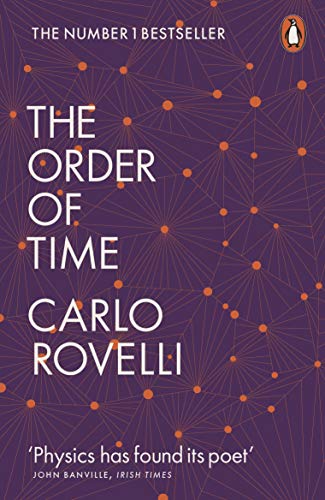
The Order of Time
von Carlo Rovelli
The link between time and heat is therefore fundamental: every time a difference is manifested between the past and the future, heat is involved. In every sequence of events that becomes absurd if projected backwards, there is something that is heating up.
Clausius introduces a quantity that measures this irreversible progress of heat in only one direction and, since he was a cultivated German, he gives it a name taken from ancient Greek, entropy: I prefer to take the names of important scientific quantities from ancient languages, so that they may be the same in all the living languages. I therefore propose to call entropy the quantity (S) of a body, from the Greek word for transformation: ἡ τροπή.6
Clausius’s entropy, indicated by the letter S, is a measurable and calculable7 quantity that increases or remains the same but never decreases, in an isolated process.
The growth of entropy is nothing other than the ubiquitous and familiar natural increase of disorder.
It is the natural disordering that leads to gradually less particular, less special situations.
The question now becomes: why, in one of the two directions of time – the one we call past – were things more ordered? Why was the great pack of cards of the universe in order in the past? Why, in the past, was entropy lower?
The notion of ‘particularity’ is born only at the moment we begin to see the universe in a blurred and approximate way.
Boltzmann has shown that entropy exists because we describe the world in a blurred fashion. He has demonstrated that entropy is precisely the quantity that counts how many are the different configurations that our blurred vision does not distinguish between.
For now, I will end with the mind-boggling fact that entropy, as Boltzmann fully understood, is nothing other than the number of microscopic states that our blurred vision of the world fails to distinguish.
Dear reader, pause for a moment to let this conclusion sink in. In my opinion, it is the most astounding conclusion arrived at in the whole of contemporary physics.
The idea that a well-defined now exists throughout the universe is an illusion, an illegitimate extrapolation of our own experience.
‘How long is forever?’ asks Alice. ‘Sometimes, just one second,’ replies the White Rabbit.
For most of those centuries, however, hours were longer in the summer and shorter in the winter, because the twelve hours divided the time between dawn and sunset: the first hour was dawn, and the twelfth was sunset, regardless of the season, as we read in the parable of the winegrower in the Gospel according to Matthew.
In 1883 a compromise is reached with the idea of dividing the world into time zones, thereby standardizing time only within each zone. In this way, the discrepancy between twelve on the clock and local midday is limited to a maximum of about thirty minutes. The proposal is gradually accepted by the rest of the world and clocks begin to be synchronized between different cities.
It can hardly be pure coincidence that, before gaining a university position, the young Einstein worked in the Swiss Patent Office, dealing specifically with patents relating to the synchronization of clocks at railway stations. It was probably there that it dawned on him: the problem of synchronizing clocks was, ultimately, an insoluble one.
Newton’s model, based on the idea of a time independent of things, has enabled the construction of modern physics – a physics that works incredibly well. And it assumes that time exists as an entity that runs in a way which is uniform and imperturbable.
Don’t take your intuitions and ideas to be ‘natural’: they are often the products of the ideas of audacious thinkers who came before us.
Time is what we speak of when we ask ‘when?’ Space is what we speak of when we ask ‘where?’
As in the case of time, Newton’s ‘container space’ may seem natural to us, but it is a recent idea that has spread due to the enormous influence of his thought. That which seems intuitive to us now is the result of scientific and philosophical elaborations in the past.
The synthesis between Aristotle’s time and Newton’s is the most valuable achievement made by Einstein. It is the crowning jewel of his thought.
Abstract thought can anticipate by centuries hypotheses that find a use – or confirmation – in scientific inquiry.
the world is nothing but change.
Time, as Aristotle suggested, is the measure of change;
The entire evolution of science would suggest that the best grammar for thinking about the world is that of change, not of permanence. Not of being, but of becoming.
We can think of the world as made up of things. Of substances. Of entities. Of something that is. Or we can think of it as made up of events. Of happenings. Of processes.
The world is not a collection of things, it is a collection of events.
The difference between things and events is that things persist in time; events have a limited duration. A stone is a prototypical ‘thing’: we can ask ourselves where it will be tomorrow. Conversely, a kiss is an ‘event’. It makes no sense to ask where the kiss will be tomorrow. The world is made up of networks of kisses, not of stones.
We understand the world in its becoming, not in its being.
‘Things’ in themselves are only events that for a while are monotonous.
Gone is the whiteness of snow – green returns in the grass of the fields, in the canopies of trees, and the airy grace of spring is with us again. Thus time revolves, the passing hour that steals the light brings a message: immortality, for us, is impossible. Warm winds will be followed by cold. (IV, 7)
Einstein changed his mind many times on fundamental questions, and it is possible to find numerous erroneous phrases of his that contradict each other.